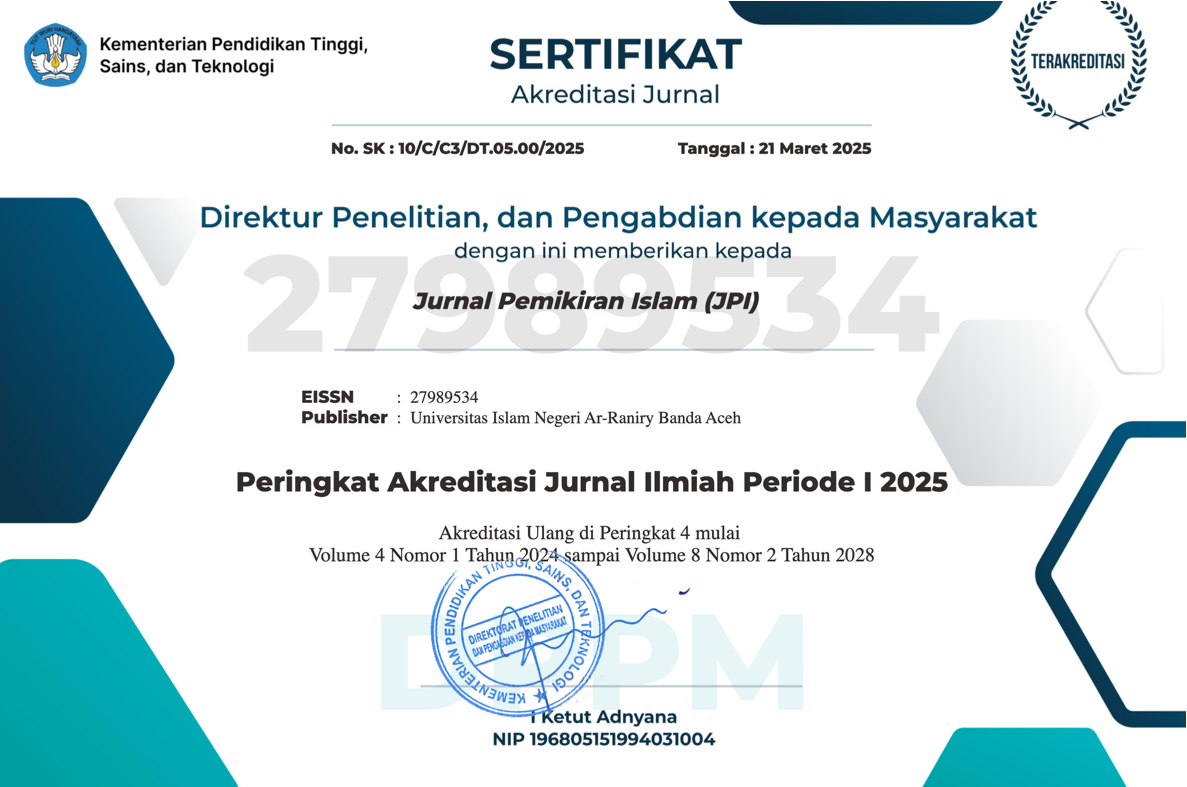The Transformation of Urban Tasawuf in Indonesia: Cybermedia and the Emergence of Digital Religion
DOI:
https://doi.org/10.22373/jpi.v4i2.24073Keywords:
Urban Tasawuf, Digital Religion, Cybermedia, Indonesian IslamAbstract
This study investigates the influence of cybermedia on urban tasawuf (Islamic mysticism) in Indonesia, focusing on its adaptation to digital platforms and the emergence of a digital religious atmosphere. A qualitative approach grounded in constructivist and interpretivist paradigms was employed. Data were collected through scholarly literature and digital sources, and analyzed thematically to examine key themes, including typologies of urban tasawuf (orthodox, marginal, modern Sufism fellowship) and their interactions with digital media. The findings reveal that urban tasawuf integrates seamlessly with digital technology, enhancing accessibility and fostering spiritual communities. For instance, the tarekat Qudusiyah uses Zoom for dzikr, and the Shift movement integrates youth culture with tasawuf. This adaptation has facilitated the emergence of a uniquely Indonesian expression of digital religion. Urban tasawuf reflects a transformative shift in religious practices through digital adaptation. However, challenges such as one-directional engagement and diluted sacredness pose risks to the depth of spiritual practices. Future research should explore specific phenomena within the paradigm of digital religion, focusing on long-term impacts on religious identity and spirituality.
Downloads
References
Afidah, I. (2021). Spiritualitas masyarakat perkotaan. 1(1).
Al-Kumayi, S. (2016). Gerakan pembaruan tasawuf di indonesia. Jurnal theologia, 24(2), 247–278. https://doi.org/10.21580/teo.2013.24.2.335
Anshori, H. M. A. (2015). Peran Tasawuf Perkotaan (Urban Sufism) dalam Mengatasi Problema Psikologis (Studi Kasus pada Kaum Eksekutif di Bandarlampung). Lembaga Penelitian dan Pengabdian Kepada Masyarakat (LP2M) IAIN Raden Intan Lampung.
Anwar, K. (2023). Relevansi Nilai Tasawuf Sosial di Era Globalisasi Menurut Habib Husein Jafar. Jurnal SMART (Studi Masyarakat, Religi, dan Tradisi), 9(2), 212–230. https://doi.org/10.18784/smart.v9i2.2070
Arvionita, D., Efendi, E., Wirman, E. P., & Zainal, Z. (2023). Tasawuf Urban dan Tasawuf Perenial dalam Kehidupan Masyarakat Perkotaan. Jurnal Pemikiran Islam, 3(1), 1. https://doi.org/10.22373/jpi.v3i1.16368
Ash-Shidiq, M. A., & Pratama, A. R. (2021). Ujaran Kebencian Di Kalangan Pengguna Media Sosial Di Indonesia: Agama Dan Pandangan Politik. Jurnal UII. https://journal.uii.ac.id/AUTOMATA/article/download/17286/10857/45441
Bingaman, K. A. (2023). Religion in the Digital Age: An Irreversible Process. Religions, 14(1), 108. https://doi.org/10.3390/rel14010108
Campbell, H. A. (2017). Surveying theoretical approaches within digital religion studies. New Media & Society, 19(1), 15–24. https://doi.org/10.1177/1461444816649912
Campbell, H. A., & Evolvi, G. (2020). Contextualizing current digital religion research on emerging technologies. Human Behavior and Emerging Technologies, 2(1), 5–17. https://doi.org/10.1002/hbe2.149
Campbell, H. A., & Vitullo, A. (2016). Assessing changes in the study of religious communities in digital religion studies. Church, Communication and Culture, 1(1), 73–89. https://doi.org/10.1080/23753234.2016.1181301
Cantwell, C. D., & Rashid, H. (2015, December). Religion, Media, and the Digital Turn. Social Science Research Council (SSRC).
Gazali, G. (2023). Urban Sufisme Eksistensi Tasawuf di Perkotaan. Majalah Ilmiah Tabuah: Ta`limat, Budaya, Agama Dan Humaniora, 27(1), 49–56.
Goldkuhl, G. (2012). Pragmatism VS Interpretivism in Qualitative Information Systems Research. European Journal of Information Systems, 21(2), 135–146. https://doi.org/10.1057/ejis.2011.54
Hakim, L. (2021). Urban Sufisme dan Remaja Milenial di Majelis Ta’lim dan Sholawat Qodamul Musthofa Kota Pekalongan. Journal ofSufism andPsychotherapy, 1(1). https://doi.org/10.28918/jousip.v1i1.127
Kholili, M., Izudin, A., & Hakim, M. L. (2024). Islamic proselytizing in digital religion in Indonesia: The challenges of broadcasting regulation. Cogent Social Sciences, 10(1), 2357460. https://doi.org/10.1080/23311886.2024.2357460
Lestari, P. (2023). Sufisme Perkotaan Era Society 5.0 (Studi Tarekat Qudusiyah di Zawiyah Yogyakarta). 1.
Log in Season 2. (n.d.). [Broadcast]. https://youtube.com/playlist?list=PLe_K9e2LM-ilpMuQv7vyrKds0FdjBznFp&si=VoMM9VaxrXAIzqYV
Malik, H. (2021). Youtube Sebagai Guru Agama di Era Cyber Religion. 1.
Maulana, A. M. R. (2022). Agama Digital (Digital Religion) dan Relevansinya Terhadap Studi Agama Interdisipliner: Sebuah Tinjauan Literatur. At-Tafkir, 15(2), 35–56. https://doi.org/10.32505/at.v15i2.4821
Mubarok, A. R., & Sunarto, S. (2024). Moderasi Beragama di Era Digital: Tantangan dan Peluang. 2(1), 1–11. https://doi.org/10.15642/jicos.2024.2.1.1-11
Muhammad Rizqy, Nur Salsa Auliya Zachani, Saniyatul Fajri, & Meity Suryandari. (2023). Pengaruh Media Teknologi Informasi Modern Terhadap Aktivitas Dakwah di Era Revolusi Industri 4.0. ALADALAH: Jurnal Politik, Sosial, Hukum dan Humaniora, 1(1), 22–42. https://doi.org/10.59246/aladalah.v1i1.146
Noer, K. A. (2015). Kebutuhan untuk Mempromosikan “Irfan” dalam Sufisme Perkotaan. Jurnal Ilmu Ushuluddin Ushuluna1, 1(1), 72–93.
Rohmawaty, E. N., & Nasrulloh. (2023). Efektifitas Aplikasi Al-Qur’an (Muslim Pro) terhadap Kemampuan Membaca Al-Qur’an Mahasiswa IAIN Kediri. AT-TAJDID: Jurnal Pendidikan Dan Pemikiran Islam, 07(02), 391–400. http://dx.doi.org/10.24127/att.v6521a2366
Setia, P., & Dilawati, R. (2021). Tren Baru Islam melalui Gerakan Hijrah: Studi Kasus Shift Pemuda Hijrah. Khazanah Theologia, 3(3), 131–146. https://doi.org/10.15575/kt.v3i3.12708
Siuda, P. (2021). Mapping Digital Religion: Exploring the Need for New Typologies. Religions, 12(6), 373. https://doi.org/10.3390/rel12060373
Solahudin, D., & Fakhruroji, M. (2019). Internet and Islamic Learning Practices in Indonesia: Social Media, Religious Populism, and Religious Authority. Religions, 11(1), 19. https://doi.org/10.3390/rel11010019
Sumarti, E., Kamalludin, K., & Nawawi, M. K. (2022). Pengaruh akun instagram teladan rasul terhadap minat dakwah masyarakat digital. Komunika: Journal of Communication Science and Islamic Dakwah, 6(1), 55. https://doi.org/10.32832/komunika.v6i1.6868
Suyitno, S. (2018). Metode Penelitian Kualitatif: Konsep, Prinsip dan Operasionalnya (A. Tanzeh, Ed.; Cetakan Pertama). Akademia Pustaka.
Trisakti, F. A. (2022). Cyber-Da’wah: Narasi Konten Video Sebagai Metode Dakwah Non-Ulama Pada Media Sosial Tiktok. Idarotuna, 3(3), 258. https://doi.org/10.24014/idarotuna.v3i3.16645
Zulfahmi, & Gani, S. A. (2024). Penerapan Artificial Intelegence Melalui Aplikasi Muslim Pro dalam Pendidikan Agama Islam. Azkia: Jurnal Aktualisasi Pendidikan Islam, 20(1). http://journal.stitalhilalsigli.ac.id/index.php/azkia
Downloads
Published
Issue
Section
License
Authors who publish in Jurnal Pemikiran Islam agree to the following terms:
- Authors retain copyright and grant the journal right of first publication with the work simultaneously licensed Attribution-NonCommercial-ShareAlike 4.0 International (CC BY-NC-SA 4.0) that allows others to share the work with an acknowledgment of the work's authorship and initial publication in this journal.
- Authors are able to enter into separate, additional contractual arrangements for the non-exclusive distribution of the journal's published version of the work (e.g., post it to an institutional repository or publish it in a book), with an acknowledgment of its initial publication in this journal.
- Authors are permitted and encouraged to post their work online (e.g., in institutional repositories or on their website) prior to and during the submission process, as it can lead to productive exchanges, as well as earlier and greater citation of published work. (See The Effect of Open Acces)














